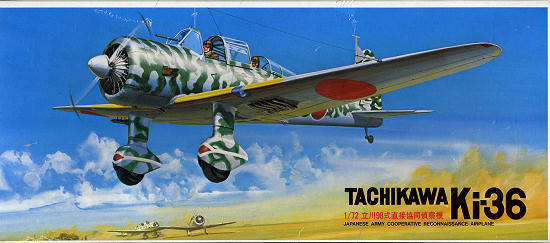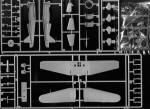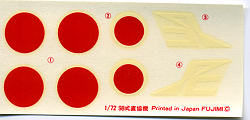
Fujimi 1/72 Ki-36 'Ida'
| KIT #: | 7A-B5 |
| PRICE: | I paid $10.50 in 2008 and $3.50 in 1984. |
| DECALS: | One option |
| REVIEWER: | Scott Van Aken |
| NOTES: |

| HISTORY |
The Tachikawa Ki-36 (codenamed Ida in allied code) was a Japanese army-cooperation aircraft of the Second World War.
The Ki-36 was a two-seat, low-wing monoplane with a single piston-engine and a fixed, tailwheel-type undercarriage.
The prototype, fitted with a 450hp (336kW) Hitachi Ha13 engine, first flew on 20th April 1938. Having outperformed the Mitsubishi Ki-35 in comparative trials, the Ki-36 was designated the Army Type 98 Direct Co-operation Aircraft and ordered into production in November 1938.
Production ended in January 1944 after a total of 1,334 had been built. The Ki-36 first saw action in China where it saw success. Later, in the Pacific, it proved excessively vulnerable to opposing fighters. It was redeployed to the safer theatre of China.
Towards the end of the war, the Ki-36 was employed as a kamikaze with a bomb of 500-kg (1,102-lb) fitted internally. The type was also operated by the PRC, who used two captured aircraft as trainers, Thailand and Indonesia.
| THE KIT |
 Back
in the 1980s, Fujimi was one of the hot model companies in terms of putting
forward new releases. Their 1/72 jet line is still one of the best around. They
also produced some smaller aircraft in one of their less expensive series that
included Alpha Jets, Hawks and some aircraft derived from the Ki-36. Even today,
if you want a 1/72 injection molded Ki-36 or Ki-55, then this is the kit you
will seek.
Back
in the 1980s, Fujimi was one of the hot model companies in terms of putting
forward new releases. Their 1/72 jet line is still one of the best around. They
also produced some smaller aircraft in one of their less expensive series that
included Alpha Jets, Hawks and some aircraft derived from the Ki-36. Even today,
if you want a 1/72 injection molded Ki-36 or Ki-55, then this is the kit you
will seek.
Now I have built this kit before and can tell you that it does fit quite well, and is not a fiddly kit at all. What it does lack, is cockpit detail, something that was not considered a major factor back then. It has a floor, two generic looking seats and a convoluted control stick that you'll probably break. There are a number of small windows that fit into the fuselage and lower wing, and the plane also has what appears to be some sliding windows for cameras or perhaps access to a radio compartment.
There is a two piece canopy set that consists of a separate
windscreen with the rest of the greenhouse molded in pine piece. It means you
cannot mold the rear gun deployed without some surgery. The engine is well
formed and fits behind a single piece forward cowling, before being placed into
the rest of the cowl section. This is separate only because the Ki-55, which
uses many of the same airframe parts, has a different engine. The fixed landing
gear spats are in two halves with the wheels molded in place.
 This kit had
broad sunken in areas on the sides of all the spats that I don't think are
prototypical. For under the fuselage, there are racks for a centerline bomb and
outer wing bomblets. The depressions for the bomblets are already molded in
place. You have to open holes for the centerline bomb.
This kit had
broad sunken in areas on the sides of all the spats that I don't think are
prototypical. For under the fuselage, there are racks for a centerline bomb and
outer wing bomblets. The depressions for the bomblets are already molded in
place. You have to open holes for the centerline bomb.
Instructions are in Japanese with color callouts for what looks like Gunze paints. Basically, it is the box art plane in IJAAF green-grey with IJAAF green variegated camouflage. These decals have yellowed, but should be somewhat usable if one bleaches them. The Hinomarus are too orange for my tastes, but one has few other options.
| CONCLUSIONS |
So there you have it. A kit that is still rather nice, can be found without too much trouble (after all, I found it at my LHS), and if you are pretty good at hand painting and have some aftermarket insignia, you can do just about any Ida for which you can find a photo.
| REFERENCES |
November 2008
If you would like your product reviewed fairly and quickly, please contact me or see other details in the Note to Contributors.